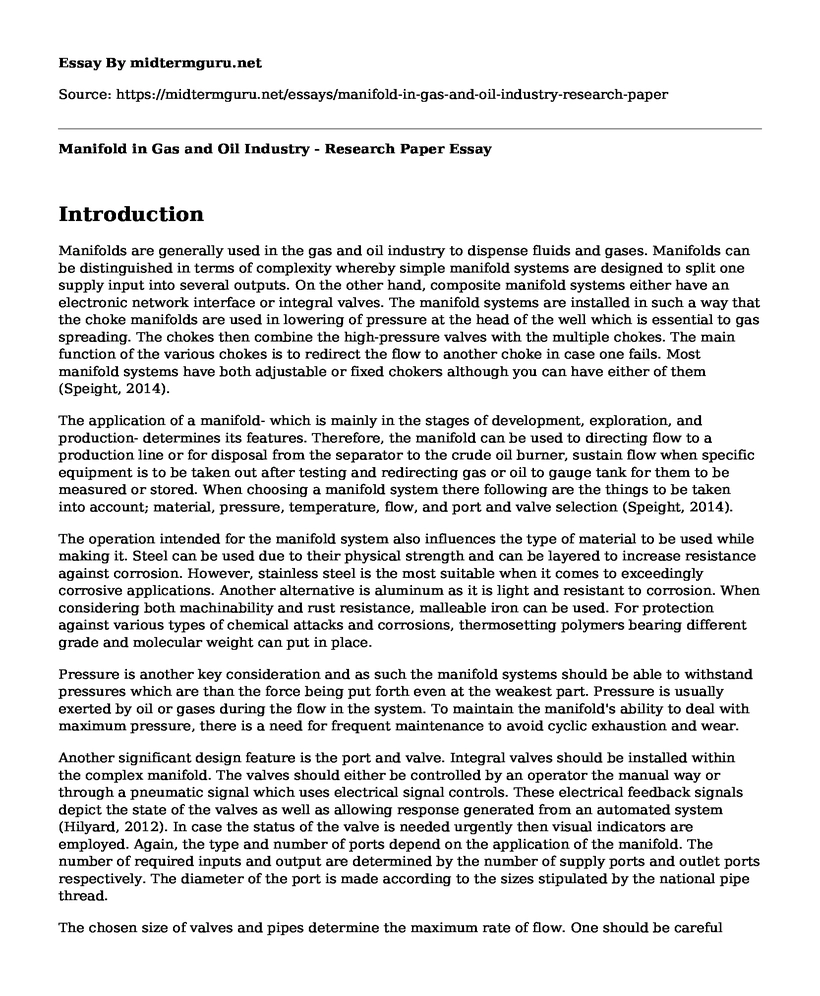Introduction
Manifolds are generally used in the gas and oil industry to dispense fluids and gases. Manifolds can be distinguished in terms of complexity whereby simple manifold systems are designed to split one supply input into several outputs. On the other hand, composite manifold systems either have an electronic network interface or integral valves. The manifold systems are installed in such a way that the choke manifolds are used in lowering of pressure at the head of the well which is essential to gas spreading. The chokes then combine the high-pressure valves with the multiple chokes. The main function of the various chokes is to redirect the flow to another choke in case one fails. Most manifold systems have both adjustable or fixed chokers although you can have either of them (Speight, 2014).
The application of a manifold- which is mainly in the stages of development, exploration, and production- determines its features. Therefore, the manifold can be used to directing flow to a production line or for disposal from the separator to the crude oil burner, sustain flow when specific equipment is to be taken out after testing and redirecting gas or oil to gauge tank for them to be measured or stored. When choosing a manifold system there following are the things to be taken into account; material, pressure, temperature, flow, and port and valve selection (Speight, 2014).
The operation intended for the manifold system also influences the type of material to be used while making it. Steel can be used due to their physical strength and can be layered to increase resistance against corrosion. However, stainless steel is the most suitable when it comes to exceedingly corrosive applications. Another alternative is aluminum as it is light and resistant to corrosion. When considering both machinability and rust resistance, malleable iron can be used. For protection against various types of chemical attacks and corrosions, thermosetting polymers bearing different grade and molecular weight can put in place.
Pressure is another key consideration and as such the manifold systems should be able to withstand pressures which are than the force being put forth even at the weakest part. Pressure is usually exerted by oil or gases during the flow in the system. To maintain the manifold's ability to deal with maximum pressure, there is a need for frequent maintenance to avoid cyclic exhaustion and wear.
Another significant design feature is the port and valve. Integral valves should be installed within the complex manifold. The valves should either be controlled by an operator the manual way or through a pneumatic signal which uses electrical signal controls. These electrical feedback signals depict the state of the valves as well as allowing response generated from an automated system (Hilyard, 2012). In case the status of the valve is needed urgently then visual indicators are employed. Again, the type and number of ports depend on the application of the manifold. The number of required inputs and output are determined by the number of supply ports and outlet ports respectively. The diameter of the port is made according to the sizes stipulated by the national pipe thread.
The chosen size of valves and pipes determine the maximum rate of flow. One should be careful when predicting the maximum flow rate. Gases are measured in standard cubic feet per minute whereas the flow rate is measured in gallons (Speight, 2014).
Manifold equipment should be designed to handle certain degrees of temperature regarding the present and future applications. The primary rationale is to prevent any mechanical damage that may occur as well as maintain the overall safety of the industry (Hilyard, 2012).
Conclusion
In conclusion, in the oil and gas industries, the manifold systems are critical as they are involved in the distribution of gases and liquids. To ensure that operations in your plant are efficient, then one should have quality manifolds tailored to address your specific needs, and this can be achieved by considering features like the material and valves among others.
Reference
Hilyard, J. (2012). The Oil & Gas Industry: A Nontechnical Guide. PennWell Books.
Speight, J. G. (2014). Handbook of offshore oil and gas operations. Elsevier.
Cite this page
Manifold in Gas and Oil Industry - Research Paper. (2022, Dec 21). Retrieved from https://midtermguru.com/essays/manifold-in-gas-and-oil-industry-research-paper
If you are the original author of this essay and no longer wish to have it published on the midtermguru.com website, please click below to request its removal:
- Essay on Exxon Valdez Oil Spill
- Reducing H2S in Khurmala Oil Field by Using Different Kind of Chemicals - Paper Example
- Essay Example on Oil: A Necessary Evil
- Oil Exploitation: Dissertation Proposal
- Essay Sample on Shell Company: Advantages and Limitations Experienced
- The Nature of Enron's Business - Essay Sample
- Oil & Gas Industry: Overcoming Ethical Challenges in a Vast Domain - Essay Sample







